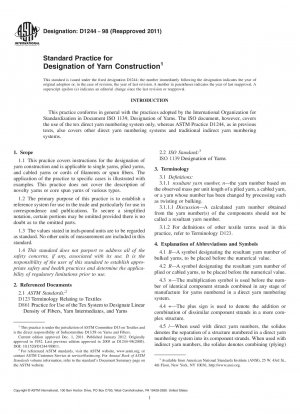ASTM D1244-98(2011)
Standard Practice for Designation of Yarn Construction
- Standard No.
- ASTM D1244-98(2011)
- Release Date
- 1998
- Published By
- American Society for Testing and Materials (ASTM)
- Status
- Replace By
- ASTM D1244-98(2020)
- Latest
- ASTM D1244-98(2020)
- Scope
The two orders of notation are presented to satisfy two separate needs encountered in the textile industry and in textile technology. The single-to-ply notation meets the needs of yarn manufacturers to describe a single yarn, or a plied or cabled yarn primarily in terms of its manufacturing specifications. The ply-to-single notation, based on the resultant yarn number, meets the needs of users of yarn who have relatively little interest in the linear density or twist of the single yarn component(s) but are interested mainly in the final product. The chief difference between the two notations is the order in which the information is presented. In this practice the same symbols are used for both notations and retain their usual mathematical meanings.
The single-to-ply notation is prescribed for yarns numbered in both direct and indirect yarn numbering systems and conforms with current usage in large sections of the textile industry. The ply-to-single notation is prescribed for yarns numbered in a direct yarn numbering system and its use is approved by the ISO/TC 38 in Document N362. This latter notation has not been included previously in Practice D1244. The ply-to-single notation has not been recommended for use with yarns numbered in indirect yarn numbering systems because of possible confusion when symbols are used with different meanings in different notations or used in conflict with their established mathematical significance.
At first glance, the recommended notation may appear rather involved, but in actuality it is a concise method for describing complex structures. For example, compare the following description of a yarn: “A cabled yarn or cord with a resultant cotton count of 1.4 and 5 turns per inch of Z twist made from 3 strands of plied yarn with 9 turns per inch of S twist each plied from 5 strands of 24 cotton count yarn with 15 turns per inch of Z twist and spun from 11/16 in. staple, graded strict low middling, and having a Micronaire reading of 4.3” with the description of the same yarn stated in Example 23,
24 Nec Z 15 tpi (cotton, 11/16 in., SLM, 4.3 Micronaire
Reading) /5 S 9 tpi/3 Z 5 tpi; R 1.4 c.c.(23) ASTM recommends (see Practice D861), the general use of the tex universal yarn numbering system.
The designation of a numbering system, for example, cotton count, woolen run, and linen lea, does not restrict the yarn composition to the named fiber. See Example 5.
The terms used to designate different yarn numbering systems are frequently abbreviated. See 4.13-4.16.
The various yarn numbering units (cotton count, tex, etc.) should be carefully distinguished from the property which has been designated as linear density. This last term covers the concept of size or fineness. The distinction is comparable to the use of the units, (litres or gallons), to express a property such as the volume of an object.
1.1 This practice covers instructions for the designation of yarn construction and is applicable to single yarns, plied yarns, and cabled yarns or cords of filaments or spun fibers. The application of the practice to specific cases is illustrated with examples. This practice does not cover the description of novelty yarns or core spun yarns of various types.
1.2 The primary purpose of this practice is to establish a reference system for use in the trade and partic......
ASTM D1244-98(2011) Referenced Document
- ASTM D123 Standard Terminology Relating to Textiles*, 2023-09-14 Update
- ASTM D861 Standard Practice for Use of the Tex System to Designate Linear Density of Fibers, Yarn Intermediates, and Yarns
- ISO 1139 Textiles; Designation of yarns
ASTM D1244-98(2011) history
- 2020 ASTM D1244-98(2020) Standard Practice for Designation of Yarn Construction
- 1998 ASTM D1244-98(2011) Standard Practice for Designation of Yarn Construction
- 1998 ASTM D1244-98(2005) Standard Practice for Designation of Yarn Construction
- 1998 ASTM D1244-98 Standard Practice for Designation of Yarn Construction
